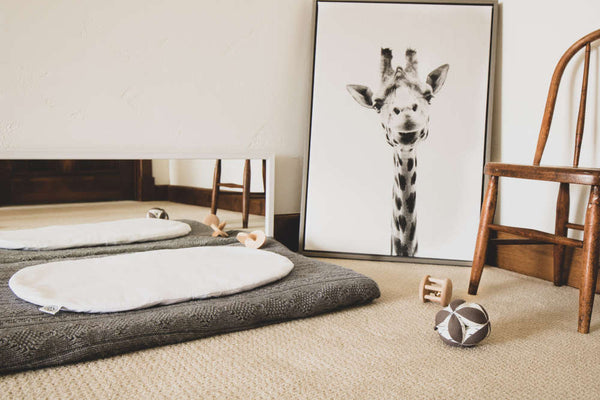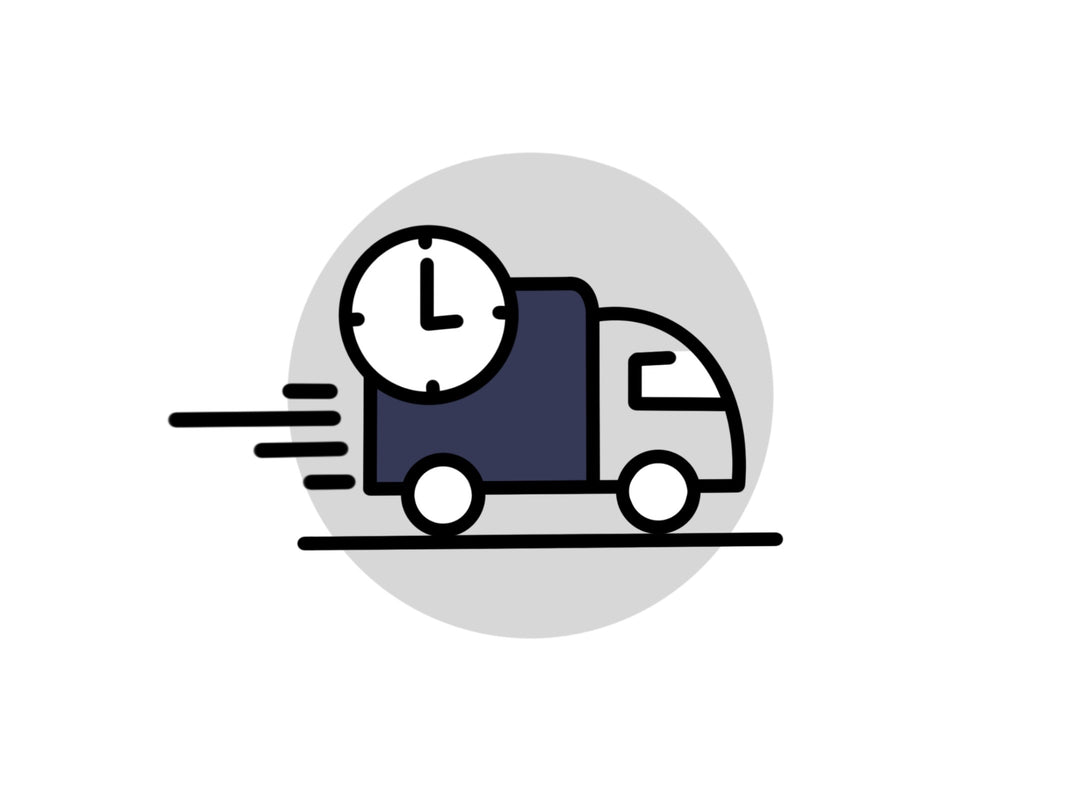The Ultimate Guide to the Montessori Topponcino
Topponcino (top.on.chi'no): A soft, mat-like Montessori baby support pillow that provides comfort, support and consistency throughout the first few delicate months of your babies life.
The Topponcino has quickly become one of the most recommended Montessori items for expecting parents.
-
It is one of the only baby products Maria Montessori specifically talked about and discussed in detail.
-
You learn how to make your own in the official Montessori Assistance to Infancy course.
-
It is written about in most Montessori books and nearly every Montessori blogger has written about it.
And we wholeheartedly agree its importance to a family cannot be overstated (This is literally why we started The Topponcino Company).
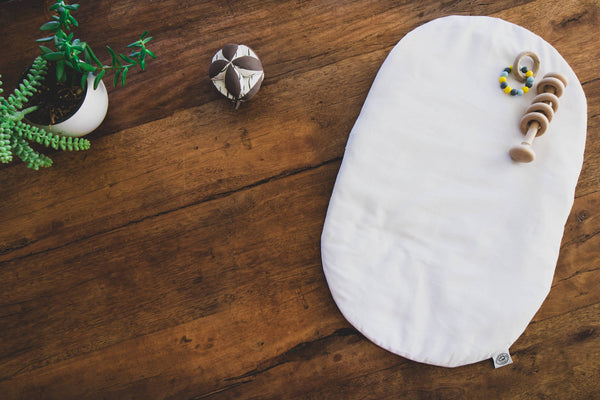
Here is what a few others have to say about it:
“This Italian Montessori wonder is a widely underused baby item probably because no one knows about it! If people knew about it - it would be a top pick for registries around the world.“
“We consider a Topponcino the single most important shower or baby gift.”
“I made sure it was packed in the hospital bag, ready to use from birth. It is also one of the few items for the Assistants to Infancy that Maria Montessori mentioned herself.”
“The Topponcino goes on my must-have list.”
“A Topponcino is a Montessori essential for families with new babies who have siblings. It’s wonderful for anyone with a new baby, though.”

For us here at The Topponcino Company, the Topponcino was the single most important item we had during our son's first few months of life. So important in fact, we have made it our mission to bring the authentic Topponcino to the modern world so that every other parent can enjoy the same life-changing experience we did.
Not only did the Topponcino make our lives better as parents, it made our son's life better too. And there is nothing better than that.
Introduction
To help you get a better understanding of the Topponcino and how it can help you and your family, we will be answering a few of our most commonly received questions:
- What is a Topponcino?
- How will the Topponcino help your family?
- How are Topponcinos made?
- How should you prepare your Topponcino?
- Are Topponcinos similar to other baby loungers?
- The Topponcino and Maria Montessori?
- What should you look for when purchasing your first Topponcino?
If you have any other questions, pease contact us so we can answer it for you and then add it to this page. If you are asking it, most likely other parents are as well!
1. What is a Topponcino?
A Topponcino (pronounced: top.on.chi'no) is a Montessori baby support pillow that provides comfort, support and consistency throughout the first few delicate months of a baby’s life.
This time-tested design has been used for generations to be a physical, emotional and psychological sanctuary of coziness.
Also referred to as transitional or security objects Topponcinos create a physical and emotional link from mom and dad to everywhere else in the external world.
They always smell like family, they will always keep your baby warm and they will always be a soft place to lay when your baby is tired.
In some Montessori homes, the Topponcino is called an “extension of mom”. Although mom might not always physically be there to hold and console, her love can always be felt through the Topponcino.
ComfortUsing a Topponcino to hold your baby provides comfort during movement or transitions. These transitions can include passing your baby from one person to another or placing your baby on a floor bed or movement mat after being held.
The Topponcino keeps your baby warm when used to place your baby on a new cold surface. Instead of startling your baby’s newly developed senses, the Topponcino becomes a barrier of warmth between their delicate bodies and any harsh new environment.
Those first few weeks of a child’s life can be overwhelming for the baby as well as for you. There is nothing worse than having your baby fall asleep in your arms only to be awoken seconds later when placed into their bed. The comfort of a Topponcino provides an ease in putting the child down after falling asleep without being awakened.
As much as we all want to hold our babies every second of every day, the reality is that our newborns need to be put down to enjoy freedom of movement and to allow us adults the time to work, maintain the home, or just have some personal space.
The Topponcino acts as a comfortable lounger for your baby so they can explore their bodies and new environment. This encourages production learning and absorption of the world around them.
SupportWhen your baby enters this world, it needs physical and emotional support. Babies are generally hearty little creatures. However, there is countless evidence that a human baby is born “too soon.” There’s no more proof of this than the fact that your new baby will not be able to hold their head up on their own.
The Topponcino ensures your baby will be supported.
This is especially useful when being held by young or older members of the family or those not familiar with holding an infant. The Topponcino provides a stable platform for your baby to ensure the newborn’s head and body is supported.
ConsistencyTopponcinos are emotional “safety objects” for your baby, providing a consistent surface which does not change temperature, firmness, or smell.
It provides a “Point of Reference” with its constant familiarity in texture, warmth, and scent. No matter who the baby is with or where the baby is in the world, the Topponcino is with them and will not change. This provides a sense of confidence in their new environment without the fear of ever changing new sensations.
To create the easiest transition for your baby, it is highly recommended that, before your baby is born, you should:
- Wash the Topponcino cover with your own detergents or soap
- Sleep with the Topponcino in your bed for at least 2 weeks.
These two steps allow the Topponcino to absorb your smell and will comfort your baby as it will always be wrapped in your scent. (Click here to read more about the preparation process ->)
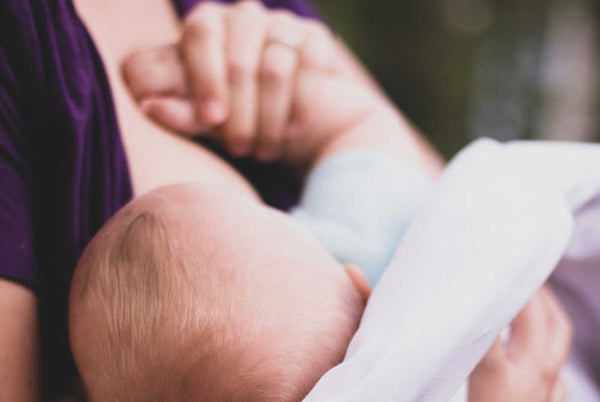
2. How will the Topponcino help your family?
People have been using the Topponcino for generations to give their baby a little oasis of calm. Although there are many uses, here are the 4 main benefits:
- Maintains a consistent temperature, smell and texture so your baby will feel safe in any environment. Like a "blankie" or "lovie" for your newborn, Topponcinos become a consistent comfort in your baby's life.
- Soothes your baby by absorbing your smell, acting as an "extension of mom and dad". By sleeping with your Topponcino for weeks before your baby is born, the Topponcino will begin to absorb your family's smell. Although you may not always physically be there to hold and console, your baby will feel as if they are forever in your arms.
- Creates a gentle barrier between your baby and cold surfaces, easing transitions such as being placed in a bed or being passed from person to person. Topponcinos are designed to maintain a consistent temperature, smell and texture.
- Physically supports your baby when feeding or when being held by those less experienced with handling a newborn. Your new baby is delicate and use of the Topponcino provides essential head, neck and body support.
3. How are Topponcinos made?
Topponcinos are constructed with the utmost attention to detail to ensure the best product for your brand new baby.
Although high-contrast patterns are good for infant development, the Topponcino is best made in soft, soothing shades of solid color like white or grey. This ensures your baby’s new environment is relaxing and calm, as patterned Topponcinos could distract from the comforting and soothing support provided by the Topponcino.
Measurements
The ideal Topponcino is sewn into oval measuring 26 inches x 17 inches x 1 inch. The oval shape allows the pillow to envelope your baby while supporting the neck, but without the risk of square corners covering their face.
The length and width provide enough space to fit your entire infant’s body, without excess fabric to overwhelm the baby. This creates the ideal combination of coziness and support.
Materials
Traditional Topponcinos are made with multiple layers of natural cotton batting which are covered in sturdy cotton muslin. Then the entire Topponcino is covered in a soft cotton cover. The multiple layers of batting provide softness without the safety risk of being “plush.”
There is fine line between a Topponcino being too hard, which would not provide your baby enough comfort, and a Topponcino that is too soft, which would not provide enough support. After hundreds of samples and tests, we found the perfect combination to maintain the upmost comfort, support, and safety of the Topponcino is seven layers of needle punched quilters batting.
Babies have incredibly soft and delicate skin, as well as developing lungs which are extremely susceptible to the toxins in the fabrics that surround them.
Be Careful!
When looking to purchase a Topponcino, make sure they are not made of polyester, free fibers or wadding, rubber foam, soft foam, or hard foam.
- Polyester is made with petrochemicals, which emit volatile organic compounds as gases after production. These VOCs can cause asthma, allergies, and other lung problems, especially for your sensitive newborn.
- Free fiber or wadding often comes in polyester form and is not bound together, creating a floppy, inconsistent, lumpy pillow that would be very difficult to clean.
- Rubber foam “off gasses”, exposing your newborn to toxins that are potentially harmful to their health. Also, rubber foam does not maintain heat or smell.
- Soft foam is extremely squishy, not providing the support of your infant’s head or body during handling.
- Hard foam is too stiff, providing support, but not providing comfort since it does not hug or conform to your baby’s body during holding and handling.
A large number of baby products today are made with polyester filling or covers. We’ve avoided these materials in all of our products.
Your newborn has sensitive skin, requiring natural fibers, not synthetic fabrics. The Topponcino is a perfect cotton barrier between our baby and anything harmful to his skin and lungs.
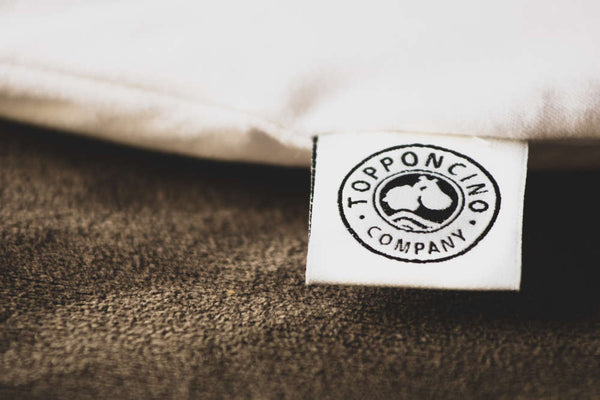
4. How should I prepare my Topponcino?
We've created all our Topponcino to the standards laid out by the official Montessori Assistance to Infancy course. This means they are made of 100% cotton, and thus require a little bit of love and attention, or they may shrink and/or pill.
Preparing Your New Topponcino
-
Wash the Topponcino cover with your own clothes and detergents
By adding the cover to a load of your clothes, you will begin the acclimation process, allowing the cover to absorb your family's unique smells. It is best if you use the same exact soaps you plan on using after your baby is born so they will associate with that as well.
-
Sleep with the Topponcino in your bed for 2 weeks (ideally)
Similar to above, this will allow the Topponcino to absorb the smell of you, the baby’s parents, and comfort your child with the familiar scent. For a baby, there is nothing better than the smell of mom and dad.
If you have any questions about preparation, please Contact Us. We are happy to help in any way possible.
Washing Your Topponcino
- Cover: It gets softer over time! But it could also shrink if washed or dried with too much heat. Machine wash cold with like colors. Tumble Dry Low.
- Insert: The internal batting is 100% cotton and is designed to trap heat and smells. It will also bunch up if washed in a machine. Spot clean by hand as needed with a damp white washcloth. Lay flat to dry.
Deep Cleaning Your Topponcino Insert
- Fill a clean bathtub, or large sink, with a few inches of cold water and a splash of liquid detergent.
- Fully submerge your Topponcino in the soapy water.
- Gently agitate for about 5 minutes.
- Drain the soapy water, and refill with fresh water.
- Gently press on the Topponcino to squeeze out the soap.
- Repeat the rinsing process until the water is suds-free.
- Sandwich your wet Topponcino between two dry towels and roll up the "Topponcino sandwich" to squeeze out the majority of the moisture.
- Unroll and air dry on a flat rack or on a thick bed of towels.
- Optional: Once nearly dry, lay your Topponcino outside on a sunny day for freshness.
PARENT TIP: Most parents get two covers so they can use one while the other is soiled or in the wash.
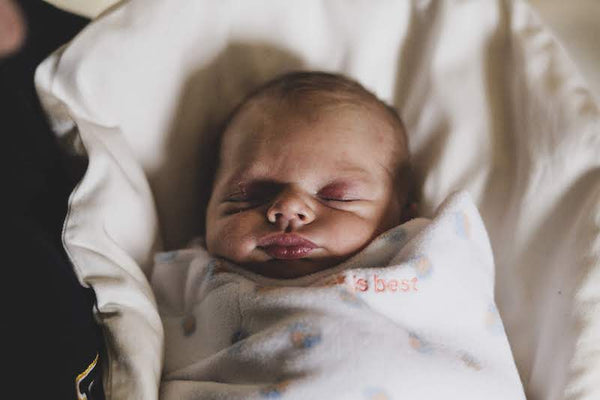
5. Are Topponcinos similar to other baby loungers?
The Topponcino is the original baby lounger.
As much as we parents want to hold our baby every second of every day, the reality is our babies need to occasionally be put down on their own to enjoy their freedom of movement (and give us parents a few minutes of "free time").
You will be able to lay your baby on the floor, in the kitchen, under a mobile or even next to your yoga mat, peacefully knowing they are comfortable and secure.
Topponcinos were first introduced to the world in the 1940s by Maria Montessori. Dr. Montessori was Italy’s first female physician, founder of the Montessori education system and three-time Nobel Peace Prize nominee.
It is said that Dr. Montessori first saw the Topponcino’s important benefits after witnessing mothers in India carrying their infants on small mats.
In her book, Education for a New World, Dr. Montessori wrote,
“The baby should remain as much as possible with the mother directly after birth, and the environment must not present obstacles to his adaptation … The child must be carefully handled and moved, not … rapidly and roughly dressed – roughly in the sense that any handling of a new-born child is rough because he is so exquisitely delicate, psychically as well as physically. It is best of all if the newborn child is not dressed, but rather kept in a room sufficiently heated and free from draughts, and carried on a soft mattress, so that he remains in a position similar to the prenatal one.”
Montessori Method
The Montessori education method is based on the principle that a child is naturally motivated to learn and grow. It is our duty as parents, grandparents, family, friends, teachers, and influencers to provide each child with an encouraging, nurturing, and safe environment.
By combining these ideas, each child will be supported to develop to their full physical, emotion, and physiological potential.
Montessori Assistance to Infancy Course
The Topponcino is one of the first projects created in the Montessori Assistance to Infancy Course. This course is designed to teach parents the Montessori principles and best practices, so they can use them from birth before their child is ready to attend a teacher-led classroom.
The Topponcino provides a comforting sanctuary necessary for the newborn and eases the infant’s transition to the harsh world around it. With the Topponcino’s consistency in smell, texture, and temperature, the newborn is not shocked by external stimulus while navigating their new senses and environment.
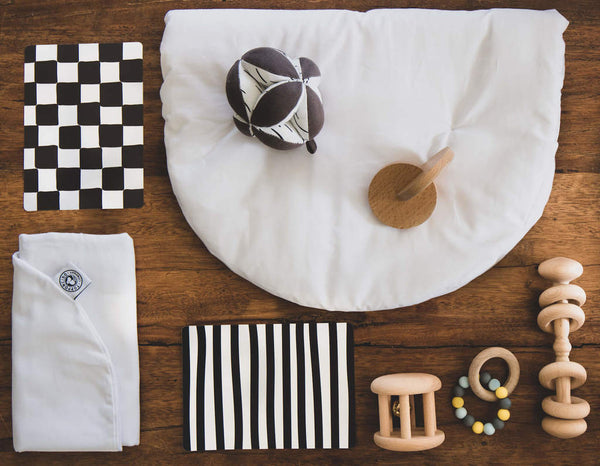
6. The Topponcino and Dr. Maria Montessori?
Maria Montessori is a legend in the education sector, and her influence lives on in the way pre-school children are taught today all over the world.
The Early Years
Maria Montessori was an extremely determined student. She originally joined an all-boys program in pursuit of graduate studies in engineering. Although she would later drop her passion for technology, she still pursued the sciences by enrolling into a medical school in Rome.
Upon graduation from medical school in 1896, she specialized in psychiatry, but it was not long before she discovered the shortfalls in education that prohibited mentally challenged children from learning naturally.
Maria Montessori was an avid reader, perhaps an influence from her parents who would be considered well educated at the time. Her father worked in a state-run institution as a financial manager while her mother came from a family that had high value for education.
Being brought up in Rome, and constantly surrounded by libraries, fine schools, and museums, Maria’s desire for education would deepen further as she grew up.
Maria did not look up to any particular individual but drew a lot of strength from her mother who was the great-niece of Antonio Stoppan, an Italian geologist, and paleontologist.
The Introduction of Psychiatry
Maria's love for children began while working at the University of Rome’s psychiatric clinic as a volunteer researcher.
She would observe children whose mental capabilities were challenged and through studying the works of two 19th-century physicians, Édouard Séguin and Jean-Marc Gaspard Itard, Maria created a focused and well-structured teaching program.
When she opened schools to impact her direction on children, people started to notice that her students paid more attention in class, were self-disciplined and exhibited high concentration.
Soon, she adopted the use of teaching aids, which proved successful because children gained reading and writing proficiency way faster than had been expected of them.
Spreading the Montessori Method
In the early years of the 1900s, Maria thought of spreading her teaching method to other teachers and went ahead to conduct the first-ever teacher training course in the Montessori school system in 1909.
By 1911, her popularity had grown to international levels causing her to give up her medical career to be able to devote more time to teaching. In her course, Maria utilized her experience with little children and how she observed them responding and interacting with the environment around them.
Today, more than 110 countries have embraced the Montessori school system for preschool education, and it is among the world's best teaching programs in both private and public schools.
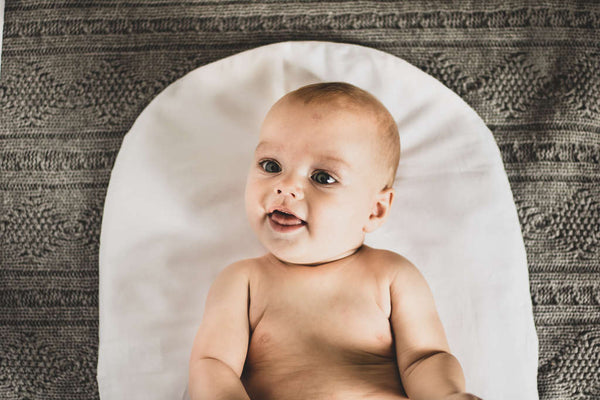
7. What should you look for when purchasing your first Topponcino?
Have you noticed that polyester is in everything these days? Even baby products! Such a bummer.
Commonly used because it is easy to make, and cheap, polyester is a synthetic fiber made from coal and petroleum.
The process of creating and treating polyester uses detergents, petrochemical dyes, formaldehyde, volatile organic compounds (VOCs), dioxin-producing bleach and chemical fabric softeners. These additives are often toxic to an adult human body, so just think how they are affecting your baby!
We at The Topponcino Company don’t think this is right.
We believe our world’s babies deserve the best, most natural products possible. That is why we are dedicated to using 100% natural materials in all our products.
For example, our Topponcino insert pillows are made of 100% natural cotton needled into a low-loft batting material. Absolutely zero polyester.
A positive side effect is that natural cotton fiber releases very low levels of hydrogen peroxide which is a well known antiseptic and disinfectant for viruses and bacteria.
Keep your baby’s health in mind…stick with natural cotton!
Make sure your Topponcino is:
- Made of 100% Cotton: Babies have incredibly soft and delicate skin, as well as developing lungs which are extremely susceptible to the toxins in the fabrics that surround them. The Topponcino should not be made of polyester, free fibers or wadding, rubber foam, soft foam, or hard foam.
- Multiple Layers of Cotton Batting: The ideal Topponcino is made with layers of cotton batting which are covered in premium cotton muslin. The batting layers provide softness without the safety risk of being “plush”. Be cautious of Topponcinos made of a single foam layer or with free fibers like an adult pillow.
- A Basic, Relaxing Color: Although high contrast patterns are good for infant development, the Topponcino is best made in soft, soothing shades of solid colors. This ensures your baby’s new environment is relaxing and calm. Patterned Topponcinos could distract from the comforting and soothing support provided by the Topponcino.
- Oval Shaped: The oval shape allows the pillow to envelope your baby while supporting the neck, but without the risk of square corners covering their face.
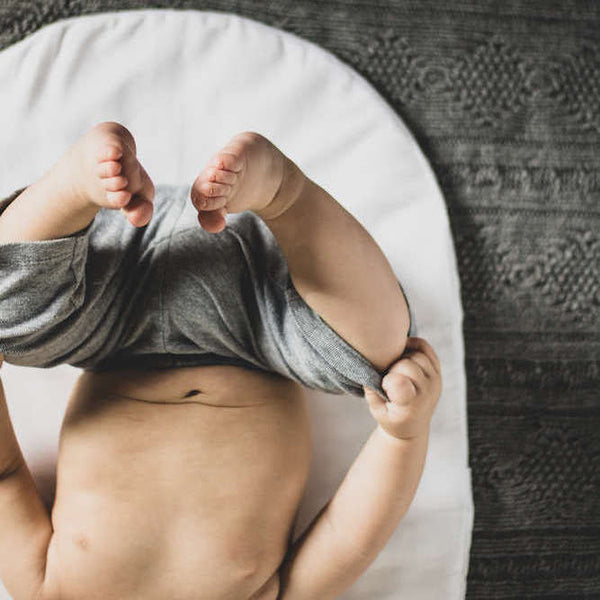
Have you ever used a Topponcino before?
Topponcinos are said to be “lagom,” the Swedish word for “just right.” They are not too soft, and not too hard. They are not too hot, and not too cold. And they are not too smooth, and not too rough. The Topponcino’s simplicity and usefulness is what makes it so emotionally valuable.
Babies are generally hearty little people. However, they are born entirely dependent on you as a caregivers. The Topponcino helps you provide your baby a psychological link to mom or dad while they learn about their new external environment and develop into “little humans.”
If you have any questions at all about the Topponcino, please contact us and we will get back to you asap.
Want to learn more? Check out our other Guides & Articles ->




